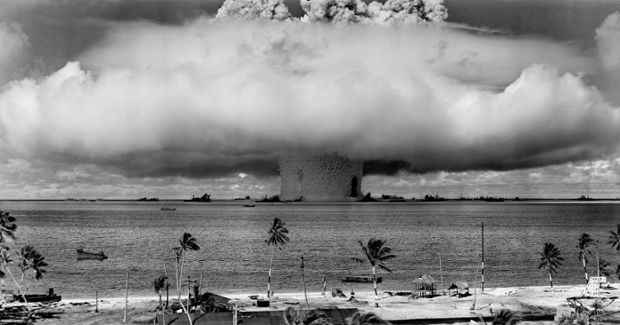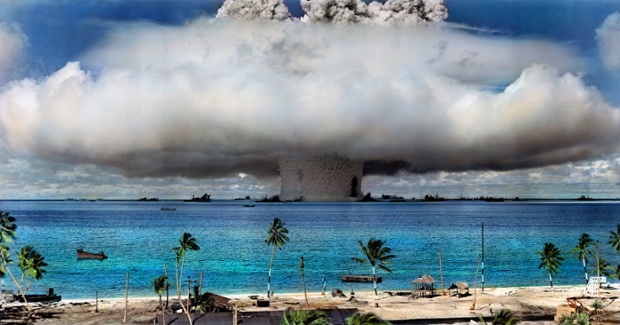 Please forget Instagram, Photoshop filters, redeye elimination, automatic camera shake reduction systems and high dynamic range apps. If you’re a true photographer or simply a lover of great photography the choice is much simpler: black and white or color.
Please forget Instagram, Photoshop filters, redeye elimination, automatic camera shake reduction systems and high dynamic range apps. If you’re a true photographer or simply a lover of great photography the choice is much simpler: black and white or color.
A new photography exhibit in London pits these contrasting media alongside each other for you to decide. The great Henri Cartier-Bresson would have you believe that black and white images live in a class of their own, far and above the lowly form of color snaps. He was vociferous in his opinion — that for technical and aeasthetic reasons only black and white photography could be considered art.
So, curators of the exhibition — Cartier-Bresson: A Question of Colour, have juxtaposed 10 of Cartier-Bressons prints alongside the colorful works of 15 international contemporary photographers. The results show that “the decisive moment”, so integral to Cartier-Bresson’s memorable black and white images, can be adapted to great, if not equal effect, in color.
The exhibit can be seen at Somerset House, London and runs from 8 November 2012 to 27 January 2013.
[div class=attrib]From Somerset House:[end-div]
Positive View Foundation announces its inaugural exhibition Cartier-Bresson: A Question of Colour, to be held at Somerset House, 8 November 2012 – 27 January 2013. Curated by William A. Ewing, the exhibition will feature 10 Henri Cartier-Bresson photographs never before exhibited in the UK alongside over 75 works by 15 international contemporary photographers, including: Karl Baden (US), Carolyn Drake (US), Melanie Einzig (US), Andy Freeberg (US), Harry Gruyaert (Belgium), Ernst Haas (Austrian), Fred Herzog (Canadian), Saul Leiter (US), Helen Levitt (US), Jeff Mermelstein (US), Joel Meyerowitz (US), Trent Parke (Australian), Boris Savelev (Ukranian), Robert Walker (Canadian), and Alex Webb (US).
The extensive showcase will illustrate how photographers working in Europe and North America adopted and adapted the master’s ethos famously known as ‘the decisive moment’ to their work in colour. Though they often departed from the concept in significant ways, something of that challenge remained: how to seize something that happens and capture it in the very moment that it takes place.
It is well-known that Cartier-Bresson was disparaging towards colour photography, which in the 1950s was in its early years of development, and his reasoning was based both on the technical and aesthetic limitations of the medium at the time.
Curator William E. Ewing has conceived the exhibition in terms of, as he puts it, ‘challenge and response’. “This exhibition will show how Henri Cartier-Bresson, in spite of his skeptical attitude regarding the artistic value of colour photography, nevertheless exerted a powerful influence over photographers who took up the new medium and who were determined to put a personal stamp on it. In effect, his criticisms of colour spurred on a new generation, determined to overcome the obstacles and prove him wrong. A Question of Colour simultaneously pays homage to a master who felt that black and white photography was the ideal medium, and could not be bettered, and to a group of photographers of the 20th and 21st centuries who chose the path of colour and made, and continue to make, great strides.”
Cartier-Bresson: A Question of Colour will feature a selection of photographers whose commitment to expression in colour was – or is – wholehearted and highly sophisticated, and which measured up to Cartier-Bresson’s essential requirement that content and form were in perfect balance. Some of these artists were Cartier-Bresson’s contemporaries, like Helen Levitt, or even, as with Ernst Haas, his friends; others, such as Fred Herzog in Vancouver, knew the artist’s seminal work across vast distances; others were junior colleagues, such as Harry Gruyaert, who found himself debating colour ferociously with the master; and others still, like Andy Freeberg or Carolyn Drake, never knew the man first-hand, but were deeply influenced by his example.
[div class=attrib]Find out more about the exhibit here.[end-div]
[div class=attrib]Image Henri Cartier-Bresson. Courtesy of Wikipedia.[end-div]



 Please forget Instagram, Photoshop filters, redeye elimination, automatic camera shake reduction systems and high dynamic range apps. If you’re a true photographer or simply a lover of great photography the choice is much simpler: black and white or color.
Please forget Instagram, Photoshop filters, redeye elimination, automatic camera shake reduction systems and high dynamic range apps. If you’re a true photographer or simply a lover of great photography the choice is much simpler: black and white or color.